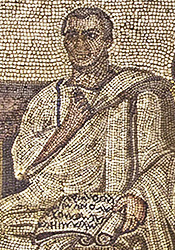Teacher's Guide to using Vergil's Thesaurus

Background: Vergil's Thesaurus is a room in the VRoma MOO designed to host online discussions of the Aeneid. It was first used during the 1999-2000 academic year by Marianthe Colakis, whose Advanced Placement Vergil class at The Covenant School in Virginia met regularly to discuss the Aeneid with Barbara McManus, Professor of Classics at The College of New Rochelle in New York. Logs of all those discussions are available in the room. To consult the logs, click on the chest labeled scribal tablets, then click on the log you want to read; when finished with one log, click the up arrow at the top of the web frame to return to the scribal tablets. After some initial difficulties with the technology setup at The Covenant School, the discussions proved to be very successful, greatly enjoyed by students and faculty alike; the Thesaurus has been used with several subsequent AP Vergil classes.
Directions to the Room: New visitors to VRoma should have a copy of the Quick Start Guide to the VRoma Learning Environment so they will have basic information about navigation and communication, plus features like the VRoma Notebook HTML Chat Log. Log in to the MOO with your character name and password or as a guest, then teleport to the Thesaurus by typing @go Vergil's and pressing Enter (or you may go to Rome and click on Region V in the map of the 14 regions).
Contents of the Room: The room is decorated with an image of the Hadrumatum mosaic of Vergil seated between the muses of history and tragedy; the room text provides more information about this mosaic plus basic instructions on how to access the room's resources. Besides the scribal tablets chest containing logs of the 1999-2000 discussions, there are five strongboxes, labeled Book 1 chest, Book 2 chest, Book 4 chest, Book 6 chest, and Books 10-12 chest, containing images of artifacts that can be used as springboards for discussion of particular sections of the Aeneid, keyed to the required passages on the AP syllabus. Each of the images is accompanied by discussion questions and links to specific lines from the text (which appear in a small pop-up window for ease of reference). The room also contains three benches which can be used for small, private discussions.
Some Potential Uses of the Room:
- The room can be re-used for online discussions between a college professor and a geographically distant AP Latin class or indeed any class studying Vergil's Aeneid. This type of online discussion works best with small numbers; the five participants in the 1999-2000 discussions were ideal, but numbers up to ten are workable. Following the discussion by reading the typed comments and responding by quickly typing one's own comment requires intense concentration; it is an excellent way to focus the mind on the topic at hand and can be a very absorbing experience quite different from face-to-face verbal discussion. The downside is that it takes more time than verbal interaction and everybody makes many typos. However, students and teacher can keep a record of everything that was said by saving their HTML Chat Logs (see the Quick Start Guide for instructions on how to do this).
- A teacher can give small groups of students a particular section of the text to discuss, instructing each of them to submit the HTML Chat Logs of their discussion. The students would agree on a time, connect to the MOO via individual computers, go to the room, access one of the images, and use the attached questions as a framework to discuss that section of text. The teacher can accept each student's log of their discussion as fulfillment of the assignment or also require that the students submit a written summary of their conclusions.
- A teacher who can hold class in a computer lab where each student has his/her own computer can break up the class into two or three small groups, assigned to bench 1, bench 2, or bench 3. Each student will go to the room and type /sit bench 1 (or the appropriate number). The three groups can all be assigned to discuss the same section of text or to discuss different sections, using the appropriate image with its associated questions as a framework. Only those “seated” at a given bench will be able to “hear” each other (i.e., see their typed comments), so three different conversations can be conducted simultaneously. One member of each group can then report their conclusions to the whole class. These reports can be given online (the student will first type /stand and then type his/her report, which can be seen by all in the room) or can be presented verbally to the class. Conversations held while seated on the benches will be recorded on the chat logs of all the students seated at a particular bench.
- Teachers with an internet-connected computer and projection system in their classroom can connect to the room, project the image and questions on the screen, and use these for verbal class discussion. They can add their own discussion questions or simply use the image; images in the VRoma Archive may be downloaded for personal, classroom, or web use.
If you have any questions about the Thesaurus or its uses, do not hesitate to contact Barbara McManus.